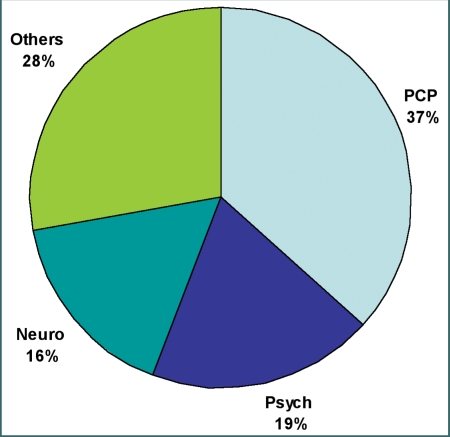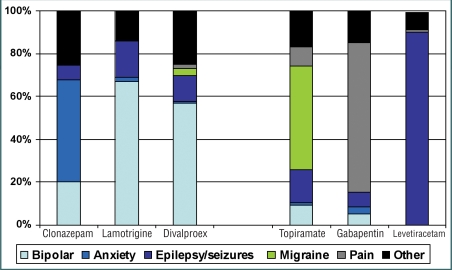The data presented in this article, as highlighted in Figure 2, clearly reveal that clinicians have embraced some of the uniqueness of each of the included seizure medications.
While all of the seizure medications reported on are effective in helping to control seizures, some, like divalproex and carbamazepine (not included in this article’s data), are also very effective for controlling mania acutely.1 Divalproex and carbamazepine are probably also effective as maintenance agents in preventing episodes of mania, though this later use has yet to be clearly proven. On the other hand, clinicians generally have realized that lamotrigine is better at treating depressive symptoms in bipolar disorder than divalproex and perhaps carbamazepine, although they each help ameliorate depressive symptoms to some degree. In contrast, divalproex and carbamazepine in numerous trials have been shown to be more effective at treating manic symptoms than lamotrigine, although lamotrigine also helps prevent manic symptoms to some degree as noted in lamotrigine’s FDA approval indication.
The presented data analysis in this article reveal that gabapentin and topiramate are still being used by a relatively small percentage of clinicians to treat bipolar disorder, though the clinical trial data clearly show that neither is effective for treating either mania or depression. Some clinicians perhaps may be taking advantage of topiramate’s ability to decrease both appetite and weight or help with alcohol abuse and dependence, as those conditions are frequently comorbid in bipolar patients. Gabapentin can also help control anxiety and pain symptoms, and perhaps clinicians have taken advantage of gabapentin being an effective treatment for these symptoms in some bipolar patients because of the abuse liability of benzodiazepines, opiates, and other pain medications.2–4
Neurologists and some psychiatrists have also taken advantage of pregabalin (not included in this article’s data), another FDA-approved an alpha 2-delta-ligand, to ameliorate pain and anxiety symptoms in a similar fashion. Not surprisingly, pregabalin, like gabapentin, does not appear to be effective in treating either manic or depressive symptoms, though several studies have shown that it is effective in some anxiety disorders. As a very large percentage of bipolar patients are being treated with multiple medications, let’s hope that gabapentin, pregabalin, and topiramate are used only in rare exceptions by clinicians as standalone treatments for bipolar disorder due to their lack of efficacy for mania or depression.
Clonazepam can, in some cases, be used to treat seizures. Far more commonly, clonazepam is used like the other benzodiazepine class members to rapidly and effectively control anxiety symptoms as reflected in the prescribing patterns. Clonazepam’s speed of response makes it a very useful drug in generalized anxiety disorder as well as panic disorder and social phobia.5 Clonazepam relieves anxiety symptoms rapidly even without chronic dosing, which is consistent with it frequently being used on an as-needed basis by clinicians in these situations. Clonazepam as a monotherapy treatment is clearly not an effective treatment for mania, and it can even exacerbate depression in some cases. This suggests that clonazepam is being used by psychiatrists to control pure or comorbid anxiety symptoms and perhaps as a sleep aide. Clonazepam also carries some abuse risks. Unlike the other seizure medications in this article’s data, abrupt discontinuation of clonazepam, even in patients without epilepsy, can lead to withdrawal seizures after regular use.
Neurologists diagnose and treat many more patients for their epilepsy than psychiatrists and this is reflected in their prescribing patterns.6,7
Neurologists also treat far more patients for migraines than psychiatrists. Not surprisingly, neurologists use more topiriamate and, to some degree, divalproex for migraine headaches as both compounds have FDA disease indications for migraines.6 Neurologists have recognized that levitracetam is a very effective and generally well-tolerated anticonvulsant. Trials seem to suggest though that levitracetam is not very effective in treating anxiety or mood disorders. Apparently, clinicians have adopted this view of levitracetam as well with wide usage by neurologists for epilepsy and little use outside of that disease area.8
All of the seizure medications in Figure 2 are also being used in a substantial minority of cases for other uses. Fibromyalgia, I am certain, represents one of the “other” common indications for gabapentin and pregabalin.9 These “other uses” may also reflect the breadth of action for antiepileptics and/or the many still unmet clinical needs that clinicians are attempting to address.
As a class, existing and future seizure medications are likely to continue to be very widely used and to remain attractive compounds both for neurologists and psychiatrists. My personal belief is that many other very exciting uses for seizure medications have yet to be identified. Kanner recently reviewed the evidence for the bidirectional link between depression and epilepsy.10 And one shouldn’t forget that neurologists and psychiatrists share a common organization for board certification for a reason, though each specialty has their own focus of practice. Unmet clinical need will likely drive this clinical exploration of new uses for antiepileptics. For example, additional and more effective treatments for posttraumatic stress disorder (PTSD),11,12 affective disorders, and traumatic brain injuries (TBI) are desperately needed at this time. A recent Rand Corporation mental health survey of recently returned troops from Iraq and Afghanistan (N=1965)13 estimates that of these 1.64 million war veterans, currently about 300,000 (18.5 %) meet criteria for PTSD or depression, about 320,000 (19.5 %) report experiencing a probable TBI, and 120,000 (7.3 %) report having PTSD or depression and experiencing probable TBI. Will some antiepileptics ultimately turn out to be of help for these soldiers and others with affective, anxiety, and cognitive problems like those who have been injured in motor vehicle accidents or assaults? In 1993, in desperation, I first tried the then unapproved drug lamotrigine under a compassionate use exemption for two very refractory patients based only on my clinical hunch and Robert Post’s anti-kindling theory. My two patients, their families, and I were pleasantly shocked a few short weeks later when lamotrigine dramatically lifted their severe unremitting depression and controlled their mood cycling. In 2003, lamotrigine was approved for bipolar disorder by the FDA.14 I know there will be more stories of new uses like this one for “seizure medications” in the future.
References
-
1.Weisler RH, Cutler AJ, Ballenger JCet al. The use of antiepileptic drugs in bipolar disorders: a review based on evidence from controlled trials. CNS Spectr. 200211(10)788–799Review. [DOI] [PubMed] [Google Scholar]
-
2.Rosenberg JM, Salzman C.Update: new uses for lithium and anticonvulsants. CNS Spectr. 200712(11)831–841Comment in: CNS Spectr. 2008;13(2):109–110; author reply 110. [DOI] [PubMed] [Google Scholar]
-
3.Zwanzger P, Eser D, Rupprecht R.[Anticonvulsants in the treatment of anxiety— an alternative treatment option?] Nervenarzt. 200778(11)1274–1282 [DOI] [PubMed] [Google Scholar]
-
4.Van Ameringen M, Mancini C, Pipe B, Bennett M.Antiepileptic drugs in the treatment of anxiety disorders: role in therapy. Drugs. 200464(19)2199–2220 [DOI] [PubMed] [Google Scholar]
-
5.Nardi AE, Perna G.Clonazepam in the treatment of psychiatric disorders: an update. Int Clin Psychopharmacol. 200621(3)131–142 [DOI] [PubMed] [Google Scholar]
-
6.Wilby J, Kainth A, Hawkins N, et al. Clinical effectiveness, tolerability and cost-effectiveness of newer drugs for epilepsy in adults: a systematic review and economic evaluation. Health Technol Assess. 20059(15)1–157 iii–iv [DOI] [PubMed] [Google Scholar]
-
7.Otoul C, Arrigo C, van Rijckevorsel K, French JA.Meta-analysis and indirect comparisons of levetiracetam with other second-generation antiepileptic drugs in partial epilepsy. Clin Neuropharmacol. 200528(2)72–78 [DOI] [PubMed] [Google Scholar]
-
8.Mulleners WM, Chronicle EP.Anticonvulsants in migraine prophylaxis: a Cochrane review. Cephalalgia. 200828(6)585–5979 [DOI] [PubMed] [Google Scholar]
-
9.Goldenberg DL.Pharmacological treatment of fibromyalgia and other chronic musculoskeletal pain. Best Pract Res Clin Rheumatol. 200721(3)499–511 [DOI] [PubMed] [Google Scholar]
-
10.Kanner AM.Depression in epilepsy: a complex relation with unexpected consequences. Curr Opin Neurol. 200821(2)190–194 [DOI] [PubMed] [Google Scholar]
-
11.Berlin HA.Antiepileptic drugs for the treatment of post-traumatic stress disorder. Curr Psychiatry Rep. 20079(4)291–300 [DOI] [PubMed] [Google Scholar]
-
12.Davidson JR.Pharmacologic treatment of acute and chronic stress following trauma: 2006. J Clin Psychiatry. 200667Suppl 234–39 [PubMed] [Google Scholar]
-
13.Tanielian T. In: Invisible Wounds of War: Psychological and Cognitive Injuries, Their Consequences, and Services to Assist Recovery. Jaycox LH, editor. Vol. 492 Santa Monica: CA: RAND Corporation, MG-720-CCF,; 2008. [Google Scholar]
-
14.Weisler RH, Calabrese JR, Bowden CL, et al. Discovery and development of lamotrigine for bipolar disorder: a story of serendipity, clinical observations, risk taking, and persistence. J Affect Disord. 2008108(1-2)1–9Epub 2007 Nov 14. Review. [DOI] [PubMed] [Google Scholar]




